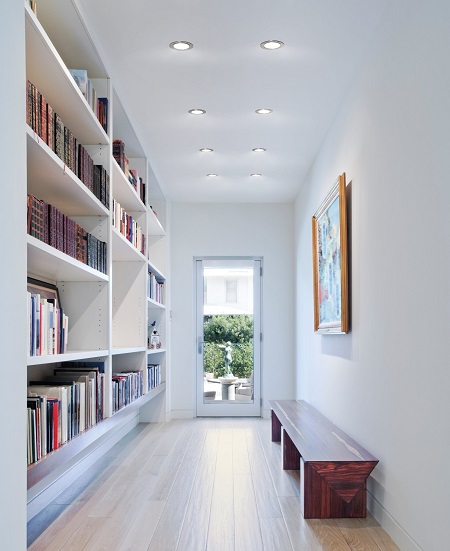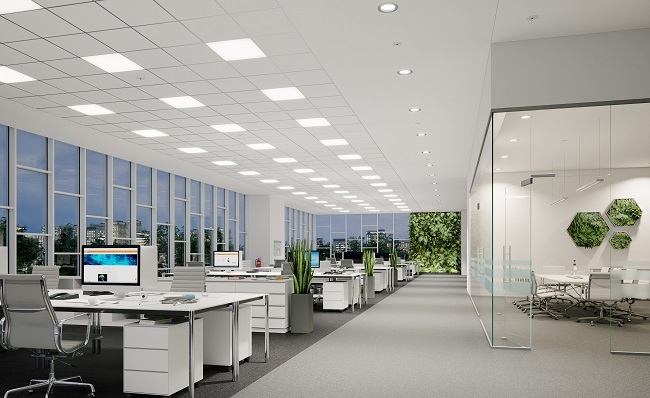Recessed lighting also known as spotlights, cans, or high hats, offers versatile design options tailored to your specific commercial needs.
Recessed lighting offers a distinct advantage over traditional pendant lighting by seamlessly integrating into ceilings. This sophisticated design not only maximizes space in rooms with lower ceilings but also transforms them into open, expansive environments. Hence, it emerges as the optimal lighting solution for commercial spaces characterized by lower ceiling heights.

In today's market, there are three prevalent types of recessed lighting:
-
Ceiling Recessed Lighting: This design creates a recessed light fixture in the ceiling, typically with lower wattage, ideal for achieving ambient lighting and enhancing the visual appeal of your workspace.
-
Wall Recessed Lighting: Featuring an angled flange, this option allows precise light direction control. These fixtures are suitable for both indoor and outdoor applications, making them a popular choice for illuminating stairs, hallways, and pathways in commercial settings.
Factors to Consider When Choosing Recessed Lighting for Installation
-
Bulb Types for Recessed Lighting
Recessed light fixtures are compatible with a variety of bulb types, including incandescent, fluorescent, halogen, and LED bulbs. Your choice depends on factors like energy efficiency, lifespan, and lighting preferences
-
Incandescent Lamps: These provide warm colors and are known for their cozy ambiance.
-
Fluorescent Lamps: Offer energy efficiency, long life, and cool temperatures. Opt for low-Kelvin fluorescent lamps to combine efficiency with warm colors.
-
Halogen Lamps: Ideal for high-intensity lighting, particularly in smaller spaces.
-
LED Bulbs: Increasingly popular due to their ability to combine energy efficiency, longevity, and versatility.
-
Size Considerations
Residential recessed lighting typically falls within the
4 to 6-inch diameter range. The right size selection should be based on factors like the intended function, location, ceiling height, and area to be illuminated. Larger diameters are suitable for higher ceilings, casting broader and more diffuse light.
-
Trim Styles
Trim styles play a crucial role in defining the aesthetics and functionality of your recessed lighting setup. They enhance ambient light while contributing to the overall visual appeal of the space.
|
Trim Type for Recessed Lighting |
Why Choose This Trim Type? |
|
Flangeless Trim Type |
It offers a distinct high-end appearance, seamlessly integrating with the floor, ceiling, or wall. This design choice not only delivers a sleek and polished aesthetic but also enhances the overall elegance of commercial and residential settings.
|
|
Flanged Trim Type |
Flanged trim offers an attractive alternative to flangeless designs. It features a subtle flange that rests on the ceiling's surface, adding a touch of definition to elevate visual aesthetics while maintaining a professional look.
|
|
Square Aperture Trim Type |
For spaces featuring unique architectural components, the square aperture trim type provides a contemporary design solution. Its design showcases clean lines and geometric shapes, making it an ideal choice for commercial and residential settings.
|
|
Round Aperture Trim Type |
It offers a classic styling that lends a contemporary touch to space. When transitioning from a traditional decor to a more modern aesthetic, it's a superb choice for remodeling projects.
|
|
Bevel Trim Type |
The bevel trim type enhances visual depth and architectural appeal. Unlike flush fixtures, the size and shape of this trim appear embedded within the wall, offering a unique design element for your commercial or residential spaces.
|
|
Flat Trim Type |
The flat trim type is suitable for recessed lighting of all shapes and sizes, delivering a sleek, minimalistic aesthetic ideal for various commercial and residential spaces.
|
-
Color Temperature
Recessed lights are typically available in 4 color temperatures:
|
Warm White (2700K) |
Warm color temperatures make you relax and feel sleepy and are often found in living rooms and bedrooms. |
|
Soft White (3000K) |
|
|
Cool White (4000K) |
Warm color temperatures make you relax and feel sleepy and are often found in living rooms and bedrooms. |
|
Daylight (5000K) |
|
Click here for more
color temperature info.
-
Housing
The housing, concealed above the ceiling, encapsulates all components of the downlight fixture. While some recessed fixtures are single units, the majority available in today's market are designed as two-piece configurations. These versatile options cater to the specific needs of commercial spaces.
Strategic Recessed Lighting Recommendations for Different Spaces
When selecting the most suitable trim for your recessed lighting installation, it's imperative to consider the surrounding environment. Making a thoughtful choice ensures the space comes to life with an enhanced and harmonious aesthetic.

-
Kitchen Lighting: When it comes to selecting recessed lighting for your kitchen, we highly recommend incorporating reflectors into your design. Opt for 4" or 5" lamps to ensure a focused, well-lit space for meal preparation and clean-up.
-
Living Room Lighting: Recessed lighting in the living room serves a multitude of purposes. If you're aiming to highlight artwork, consider wall wash options. Additionally, for spaces with sloped ceilings, choose lights with sloping trim for an elegant and functional solution.
-
Outdoor: Outdoor recessed lighting is built to withstand the harshest elements, including rain, storms, and extreme temperatures. Available in various sizes and trims, these fixtures offer a range of unique features to enhance your outdoor spaces.
Bonus Tips: Downlight VS. Recessed Lighting
The primary distinction between downlights and recessed lights lies in their installation method. The installation of recessed lights can be more intricate when compared to downlights, as it involves cutting multiple uniform-sized holes in the ceiling. Furthermore, mounting them on the ceiling can be more intricate than wall installations.

Recessed lighting offers a minimalist way to illuminate a space, effectively minimizing visual clutter. This option is particularly advantageous for spaces with low ceilings, as it maintains a seamless ceiling profile without protrusions.
In such settings, hanging fixtures, or even flush mounts, can sometimes create an illusion of reduced space. By utilizing low-voltage recessed lights equipped with
MR16 bulbs featuring a variety of beam spreads, it becomes possible to achieve finer control over room lighting when compared to traditional ceiling fixtures.
Thanks to low-voltage bulbs and adjustable trim options on recessed cans, recessed lighting frequently emerges as the preferred lighting solution. Have additional questions? Feel free to reach out to the
LEDVANCE sales team!



